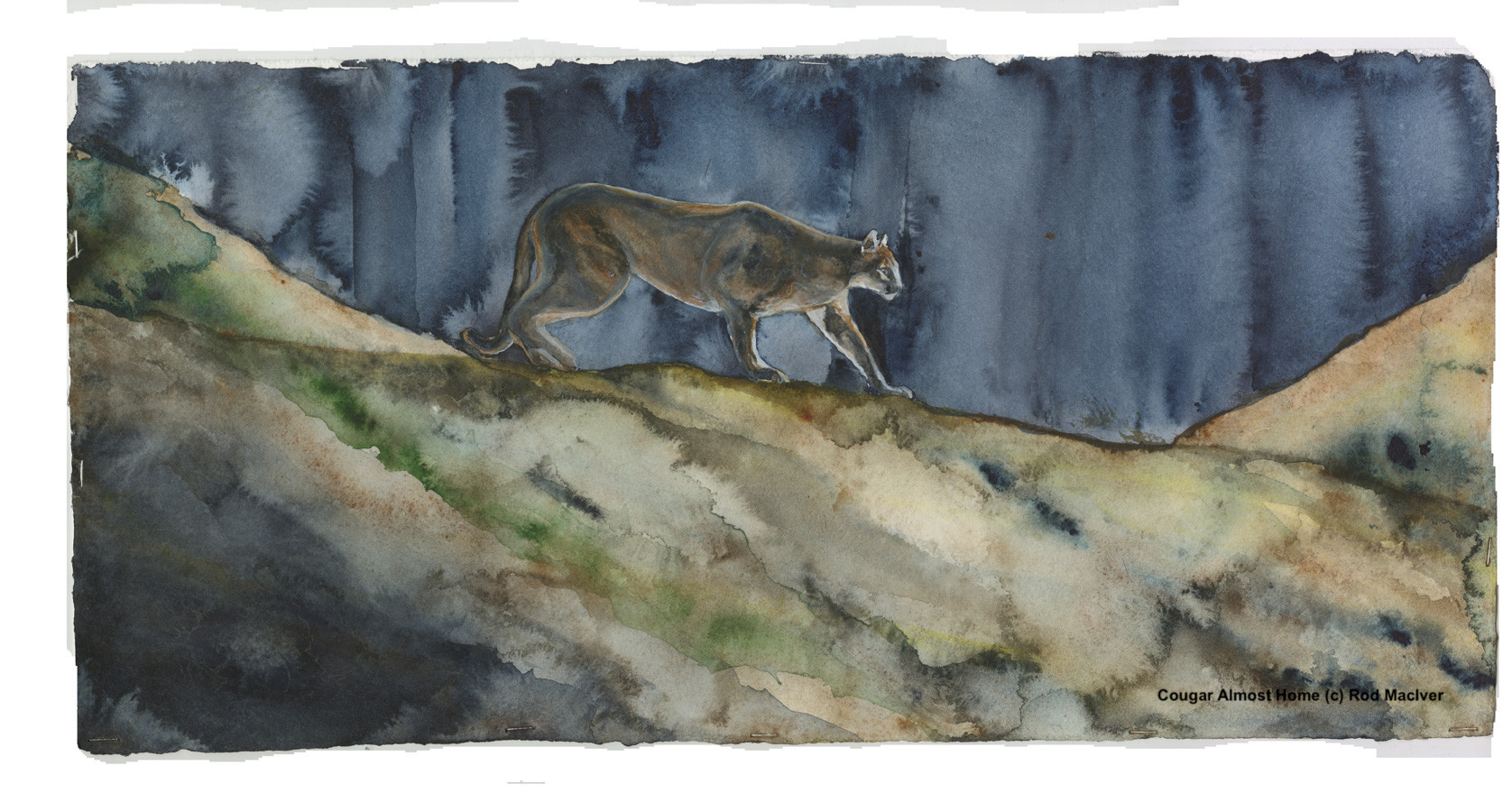The Limitations of Puma Recolonization and the Strategy to Bring ‘Em Back

Cougar Almost Home © Rod MacIver
The mythic ghost-cat ain’t coming back. Not on her own. The recently convened Cougar Research Collaborative (CRC) — including researchers from Panthera, the world’s premier big cat NGO — announced in a pair of East Coast spring conferences that their modeling for pumas to recolonize the cat’s historic range eastward won’t be happening any time soon. Discouragingly, recovery may not progress much from the puma’s easternmost breeding colony in central Nebraska’s Niobrara River Valley before the end of this century. Peer-reviewed publication of the modeling may appear within the year.
The announcement caps a flurry of Midwest and Eastern puma recovery research and its attendant publicity by several NGOs, including a New York Times Op-Ed from lead Panthera puma biologist Mark Elbroch, over the past year. Identifying potential habitat locations, recolonization corridors, and demographic surveys of the public’s taste for puma restorations, the research represents an unprecedented spike in puma recovery interest. How’d we get here?
Since the mid-1990s, dozens of sub-adult pumas from breeding colonies in the Dakotas and Nebraska have dispersed east, sparking speculation that they will first recolonize the Midwest, then recover some of the cat’s eastern range, without the need for reintroductions. Most dispersers have been males. All but one, perhaps, have died, disappeared, or were captured without establishing a home range. The oldest puma documented east of the prairie states, who traveled famously from the South Dakota Black Hills — the largest prairie colony of 200 cats and the primary source of dispersers — to Connecticut, was three-years-old. Legendary carnivore ecologist, John Laundré once wrote in Rewilding Earth that these doomed dispersers were “Dead Cats Walking.”
Speculation regarding the potential for recolonization has been split. The Cougar Network (CN) has produced several studies first documenting the stepping-stone recolonization from meta-population sources in the Rockies to the prairie states of the Dakotas and Nebraska. These were followed up by modeling hunting pressure in the prairie colonies, including tracking dispersal mortalities on recovery eastward. CN concluded recolonization remains viable eastward despite hunting pressures, reinforced by recruitment of dispersers from the western meta-population into the prairie colonies.
In contrast, the Cougar Rewilding Foundation first suggested overhunting in the Black Hills would limit dispersal and further recovery to the east. Hunting quotas were raised dramatically in 2011 under South Dakota’s updated management plan, which ignored at the time a fierce, concerted challenge from puma biologists, advocates, and NGOs. Both Dakota states manage their populations with sub-quotas targeting breeding females. Perpetually limiting the population, targeting females suppresses recolonization from the North Dakota Badlands and Black Hills east, where pumas can be killed 24/7 year-round in the Dakotas outside the managed hunting districts. South Dakota has not hit any of its quotas or female sub-quotas since exceeding the first quota in 2012. Despite disperser recruitment from the larger meta-population, those policies have indeed reduced the number of dispersers measured by mortalities and captures in the Midwest to a trickle since 2011 (Wild Felid Monitor, Summer 2017), which remains the record year for eastward dispersers — a direct reflection of the hunting quotas and year-round killing outside the hunting districts.
The wild card for recolonization remains Nebraska. Unlike the Dakotas, Nebraska protects pumas throughout the state. With three tiny colonies, and hunting to date in just the largest, Pine Ridge National Forest in northwest NE with roughly 30 adults, a curious development began in 2015 — females started turning up east of the prairie states. Typically sticking within 100 miles of their birthplace, several prairie females have been documented traveling more than 600 miles. In late January 2023, a female puma was shot and killed by coyote hunters in Johnson County, Iowa. Pumas are not protected in Iowa. She was the third female shot in Iowa in the past six years, and just the fifth female puma documented since 2002 in states east of the prairie colonies. Of the five females found in the Midwest, three were shot, and one was confirmed in 2016 only by DNA extracted from a Missouri elk-kill. The earliest female disperser, and possibly the longest female dispersal on record, was confirmed in Tennessee in 2015 by trail cameras and DNA matched to the Black Hills.
Her story is indicative of dispersers ranging east. Despite pumas being a protected species in Tennessee, her DNA was gleaned from a bow-hunter’s broadhead that nicked her. Like so many disappeared males who preceded her for twenty years, her disappearance after a year of confirmations, and the bow-hunting incident, suggest poaching may take a significant number of dispersers. However, several self-defense claims, even when the poachers are caught lying about the circumstances, have resulted in just one poaching conviction.
The Nebraska colonies have not been separated long enough from the Black Hills population to distinguish regional DNA. The Niobrara River Valley, the easternmost puma colony north of Florida, contains maybe 20 adults. I asked Sam Wilson of Nebraska Game and Parks if the Niobrara was at carrying capacity, and if those female dispersers might be coming from the Niobrara: Wilson replied “No,” and “No.” He believes female dispersers could be ranging not only from any of the prairie colonies but also from further west. Nebraska Game and Parks’ commissioners recently approved hunting in the Niobrara. Whatever their source, dead and disappeared females cannot breed. Puma kittens have yet to be documented in states east of the Dakotas and Nebraska.
Prairie-state recolonization has taken twenty-five years to recover 250 miles from the Black Hills east to the Niobrara across some of the Lower 48’s least developed terrain. It is another 230 miles from the Niobrara through landscapes increasing in industrial agricultural, development, and human populations to the Iowa border — where dispersal hazards clearly multiply. One of CN’s studies suggested recolonization of the Midwest could happen within twenty-five years by the cats using patch habitats on their way to bigger, better locations in north central Minnesota and the Ozarks, 450 and 600 miles, respectively, to their closest colonies west. The Cougar Research Collaborative’s modeling challenges the Cougar Network’s recolonization projections, and confirms Cougar Rewilding Foundation’s apprehensions.
If puma recolonization in the Midwest has indeed stalled, how then to restore the cat-of-one-color to all of their former range, from the Boundary Waters to the Great Smokies, from the Ozarks to Acadia? Part 2 of this article will explore several recovery options for the two-thirds of the country missing pumas.
Christopher Spatz, inspired by Dave Foreman announcing the birth of Earth First! on the Today Show in the early ’80s, procured a copy of Eco Defense and began his peripatetic pursuits as an eco-gadfly. Yanking surveying stakes, canvassing for Greenpeace in Boston, performing for Trenton, NJ’s Klark Kent eco-street theater troupe, directing the Gunks’ Climbers Coalition, and advocating for puma recovery as the president of the Cougar Rewilding Foundation were some of his ventures. He lives and writes from the Shawangunks in southern New York State.



If we could reintroduce the puma to the Great Smoky Mountain National park and the Adirondack Mountains and surrounding US Forest Service property that would provide a much shorter path for dispersing lions to repopulate the rest of the East. Has this concept been explored?